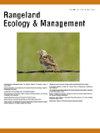The Influence of Grazing on the Spatiotemporal Activity Patterns of a Primary Sage-Grouse Nest Predator
IF 2.4
3区 环境科学与生态学
Q2 ECOLOGY
引用次数: 0
Abstract
Perturbations in ecological processes can occur when wildlife alter their spatiotemporal activity patterns to avoid human activities that they perceive as a risk. Such perturbations can have cascading effects throughout wildlife communities. For greater sage-grouse (Centrocercus urophasianus; hereafter sage-grouse), nest predation plays an important role in population dynamics. Domestic cattle (Bos taurus) grazing has been hypothesized to increase nest predation by reducing grass height, and therefore reducing nest concealment, which may facilitate nest detection by predators. Grass height is lower on grazed pastures, but sage-grouse nest success appears similar on pastures grazed at varying intensities in several recent studies. Any reductions in nest concealment caused by grazing could potentially be offset by a localized response of one or more nest predators to the presence of cattle (i.e., the cattle avoidance hypothesis). A reduction in nest predator density or relative use within pastures could explain similar patterns of nest success on pastures grazed at varying intensities. Also, wildlife can potentially partition themselves temporally to avoid risks associated with human activities. For example, a shift in diel activity patterns by nest predators in response to cattle could result in predators being active during portions of the day when they are less efficient at locating sage-grouse nests. Thus, the effects of grazing could be offset by a temporal avoidance of cattle by predators. We deployed motion sensor cameras across six pastures to evaluate whether coyotes (Canis latrans; a primary sage-grouse nest predator) altered spatiotemporal activity patterns in response to cattle. We found that the probability of detecting coyotes had a positive relationship with cattle detections at camera sites (β = 0.22; 95% CI = 0.14,0.30). We also found that coyotes did not shift their diel activity patterns in response to cattle being in the pastures. Thus, in our system, similar sage-grouse nest success among pastures with different grazing intensities cannot be explained by the cattle avoidance hypothesis, at least for coyotes.
放牧对原始鼠尾草-松鸡巢捕食者时空活动模式的影响
当野生动物改变其时空活动模式以避免它们认为有风险的人类活动时,就会发生生态过程的扰动。这样的扰动会对整个野生动物群落产生连锁效应。对于大鼠尾草(centroccercus urophasianus;因此,巢捕食在种群动态中起着重要作用。家牛(Bos taurus)的放牧被假设为通过降低草的高度来增加巢穴捕食,从而减少巢穴的隐蔽性,这可能有助于捕食者发现巢穴。放牧草场的草高较低,但在最近的几项研究中,不同强度放牧草场的艾草松鸡筑巢成功率相似。放牧引起的巢穴隐蔽性的任何减少都可能被一个或多个巢穴捕食者对牛的存在的局部反应所抵消(即,牛回避假说)。牧场内巢穴捕食者密度或相对利用的减少可以解释在不同强度放牧的牧场上筑巢成功的类似模式。此外,野生动物可能会暂时隔离自己,以避免与人类活动相关的风险。例如,筑巢捕食者的日常活动模式的变化对牛的反应可能导致捕食者在一天中寻找鼠尾草巢穴的效率较低的部分活动。因此,放牧的影响可以被食肉动物暂时避开牛群所抵消。我们在六个牧场部署了运动传感器摄像机,以评估土狼(Canis latranans;一个主要的鼠尾草巢穴捕食者)改变了时空活动模式,以响应牛。我们发现土狼的检出率与牛的检出率呈正相关(β = 0.22;95%可信区间 = 0.14,0.30)。我们还发现,土狼并没有因为牧场上有牛而改变它们的饮食活动模式。因此,在我们的系统中,在不同放牧强度的牧场中,相似的鼠尾草筑巢成功率不能用避牛假说来解释,至少对土狼来说是这样。
本文章由计算机程序翻译,如有差异,请以英文原文为准。
求助全文
约1分钟内获得全文
求助全文
来源期刊

Rangeland Ecology & Management
农林科学-环境科学
CiteScore
4.60
自引率
13.00%
发文量
87
审稿时长
12-24 weeks
期刊介绍:
Rangeland Ecology & Management publishes all topics-including ecology, management, socioeconomic and policy-pertaining to global rangelands. The journal''s mission is to inform academics, ecosystem managers and policy makers of science-based information to promote sound rangeland stewardship. Author submissions are published in five manuscript categories: original research papers, high-profile forum topics, concept syntheses, as well as research and technical notes.
Rangelands represent approximately 50% of the Earth''s land area and provision multiple ecosystem services for large human populations. This expansive and diverse land area functions as coupled human-ecological systems. Knowledge of both social and biophysical system components and their interactions represent the foundation for informed rangeland stewardship. Rangeland Ecology & Management uniquely integrates information from multiple system components to address current and pending challenges confronting global rangelands.
 求助内容:
求助内容: 应助结果提醒方式:
应助结果提醒方式:


